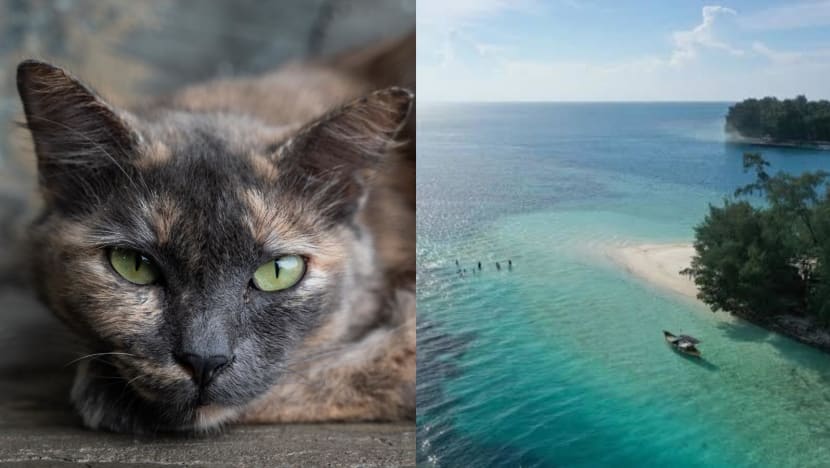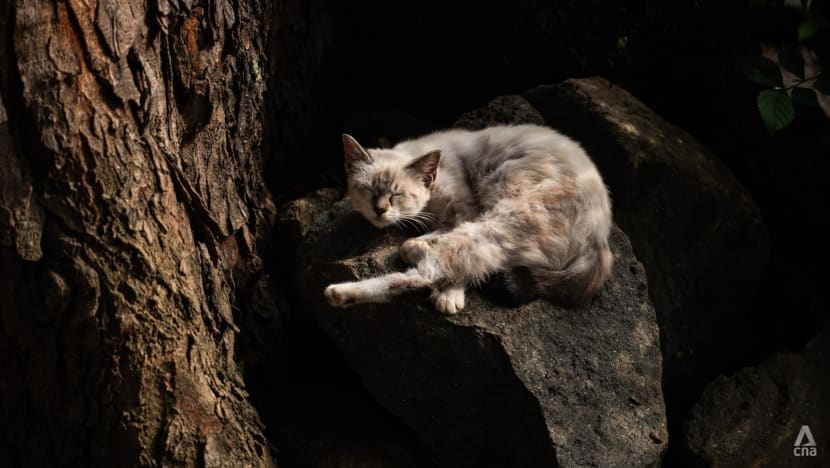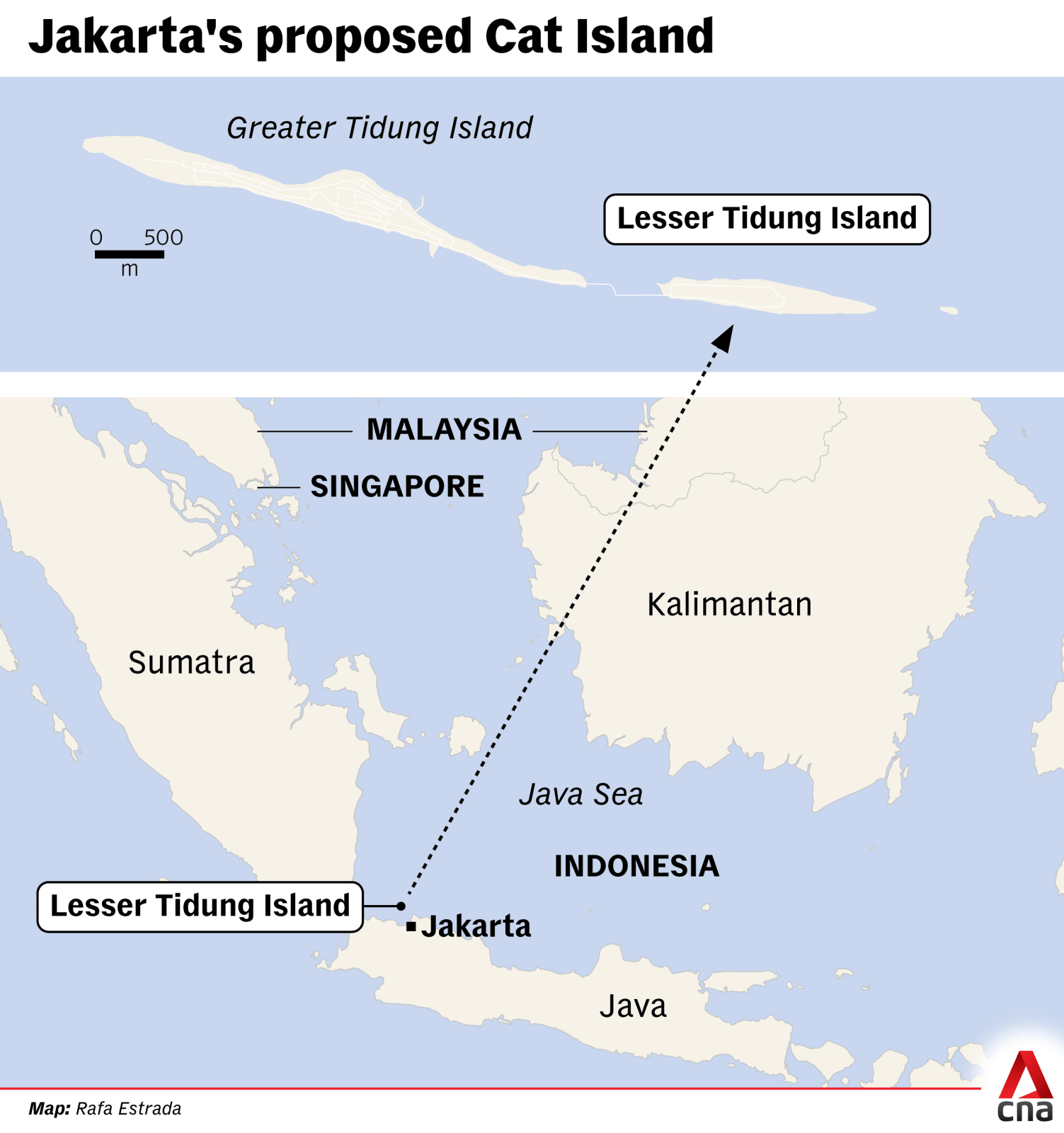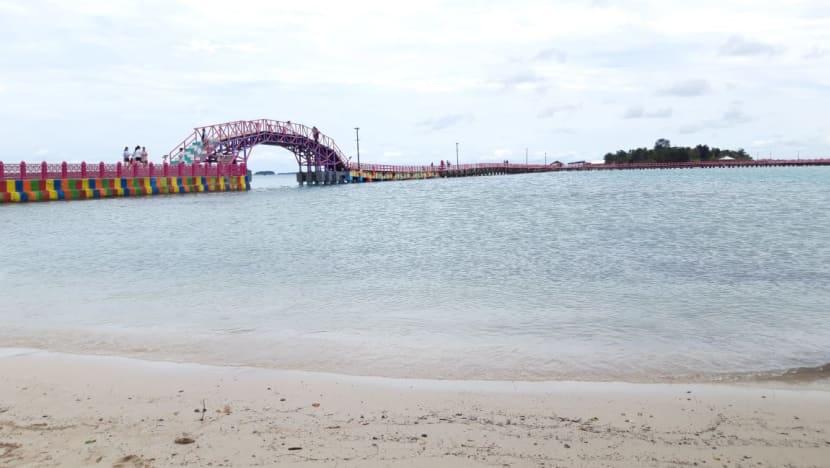‘Cat island’ in Java Sea? Jakarta mulls moving stray felines offshore but experts flag concerns
Indonesia’s capital has 750,000 stray cats and the city government wants to use an offshore island to house 1,000 of the felines. The plan could draw tourists but harm wildlife, experts caution.

Could an island in Indonesia's Thousand Islands regency become a cat sanctuary? (Photos: CNA/Wisnu Agung Prasetyo, Thousand Islands regency)

This audio is generated by an AI tool.
JAKARTA: Fancy visiting an idyllic island in the Java Sea that is home to 1,000 rescue cats?
Indonesia could soon have a “cat island” modelled after the ones in Japan, if Jakarta governor Pramono Anung has his way.
On May 15, Pramono revealed that the city government is considering populating one of the hundreds of islands off the coast of Jakarta with cats in an effort to manage their population and boost tourism.
“The idea about a cat island is not new. Japan has established ones and they have become extraordinary tourist destinations,” the governor told reporters, as quoted by Indonesian news portal Tempo.
On islands such as Aoshima and Tashirojima in Japan, cats vastly outnumber human inhabitants after they were brought in to control the rat population. The presence of these four-legged creatures has put these islands on the map, attracting cat lovers and curious visitors from around the world.
“If we can make it happen, the island can be a source of revenue (for Jakarta),” Pramono said, without providing a timeline.
The governor said ever since he took office in February, keeping Jakarta's cat population in check has been one of the top demands made by residents. After discussing with several experts, the idea to build a cat island was born.
According to a 2024 estimate by the city government, Jakarta is home to 750,000 stray and 110,000 domesticated cats.
With cats capable of producing three to four litters of kittens a year, experts predict the figure could quadruple in the next five years, heightening the risk of disease transmission, human-animal conflicts and ecological imbalance.
Jakarta has the manpower and budget to only sterilise around 20,000 cats – feral or domesticated – every year, so finding spaces big enough to shelter the rescued animals in a sprawling metropolis of 11 million people is also a challenge.
This is one of the reasons the city is turning its attention to the Thousand Islands, a chain of islands which stretches up to 160km northwest from Jakarta’s mainland.


Contrary to its name, there are around 340 islands and islets in the archipelago.
Many of these islands have been populated by traditional fishermen for generations while others have been turned into popular tourist resorts. Some are uninhabited or manned by only a few people.
“The cats will not be abandoned on this cat island,” Hasudungan Sidabalok, chief of the Jakarta Food Security, Fisheries and Agriculture Agency, which oversees all animal affairs, told CNA.
“We will build a comfortable space for them where they will be well taken care of and groomed. People can visit this island which serves as both a tourism and an educational destination.”
Hasudungan said the island will host primarily rescued strays and abandoned pets. “(The city government) estimated that there will be 1,000 cats on this island and we will take care of them,” he said.
But the idea of relocating cats to an island in the middle of a sometimes inhospitable sea has proved to be controversial among experts and activists, who say the cats may not be able to adapt to the new environment or may upset the Thousand Islands’ delicate habitat and wildlife.
THREAT TO LOCAL BIRDS AND OTHER ANIMALS?
Thousand Islands’ acting regent Muhammad Fadjar Churniawan said his team has been scouting for a viable island for the cats.
“Of the islands we surveyed, the Lesser Tidung island is most suitable,” the regent said on May 21 as quoted by Antara news agency.
The island’s 0.32 sq km area, flat terrain and existing infrastructure make it suitable for a cat sanctuary, he said.
The Lesser Tidung island is virtually uninhabited and used primarily for conservation efforts, unlike its neighbour, the Greater Tidung, which is located 500m away and home to 1,000 people.
Both islands are popular with tourists from mainland Jakarta, some 55km away.

Members of the Jakarta city council are divided on the idea of turning Lesser Tidung into a cat island.
“The Lesser Tidung island is a nature conservation area so the entire flora and fauna there must be protected,” council member Francine Widjojo told CNA. The island is currently home to a sea turtle hatching site and a mangrove seeding ground.
“Cats are predators and they can eat birds, mammals, reptiles and amphibians. They can be a threat to conservation efforts,” the Indonesian Solidarity Party (PSI) politician added.
Council members who support the proposal say it can attract more tourists to the Thousand Islands.
“If executed poorly then (the programme) can backfire. But if done seriously it can be a tourist magnet just like the ones in Japan,” said city councillor Taufik Zoelkifli of the Prosperous Justice Party (PKS), as quoted by Tempo.

Femke den Haas, founder of one of Indonesia’s most prominent animal rights groups, the Jakarta Animal Aid Network, said the entire Thousand Islands archipelago is no place for cats.
“The Thousand Islands is home to many species which need to be protected. If the city government wants to put hundreds of cats on a small island, will they not catch the local wildlife?” Femke told CNA.
The Thousand Islands is home to the brahminy kite, also known as the red-backed sea eagle, which Jakarta adopted as its official bird. The archipelago is also a stopover for many migratory birds.
Cats are already a big problem in the Thousand Islands, including on Lesser Tidung island, Femke said.
There are islands which are being overrun with cats because people from the populated islands are dumping unwanted cats on unpopulated ones. There are also pets that became feral after their owners died or moved to mainland Jakarta.
These cats later reproduced and became a threat to the area’s wildlife.
The cats themselves suffer as they fight with one another or other predators for food. These stand-offs sometimes lead to death or serious injuries.
“And now the government wants to spend money to send more cats to the Thousand Islands?” Femke questioned.
CITY’S THINKING THINGS THROUGH
Hasudungan of the Jakarta agriculture agency said opposition towards the proposed cat island is “premature” as the city government will ensure the cats are well taken care of and endemic wildlife is protected.
“We are in consultation with several environmental experts. They will conduct studies and make recommendations so the cat island can run sustainably,” he said.
The city also welcomes animal rights advocates and conservation groups to get involved in running the island and caring for the cats.
“The presence of a cat island does not mean that we will stop our sterilisation programme or stop building animal shelters,” Hasudungan added. “This is just another tool to control the ever-growing population of cats in Jakarta.”
He said the main objective of the project is to promote a love for animals and educate the public about the importance of cat sterilisation and vaccination.
“At the same time, we can empower the local community and provide jobs as medical professionals or operational staffers. People can also sell food and cat-related souvenirs like T-shirts. Meanwhile, we can use cat excrement to generate biogas,” he said.

The city government envisions the island will have an animal clinic, an exhibition room and a place where visitors can interact with the cats, which Hasudungan said will all be sterilised before they are relocated.
The facility will be enclosed so the cats do not wander and endanger local wildlife.
“We are thinking things through to make sure that the project is sustainable and does not have any negative impact on the environment,” he said.

WILL PEOPLE VISIT THE CAT ISLAND?
Residents on the islands have mixed feelings about the plan.
“Some residents supported this plan because we could see more tourists coming and new economic opportunities emerging,” Greater Tidung Island resident Mukti told CNA.
"But there are residents who wonder if the cats will encroach on our island, steal our food, eat our fish catch and become a nuisance to the community."
The Greater and Lesser Tidung islands are only separated by 500m of water and a wooden bridge.
Jakartans are also ambivalent about the plan.
“The cats will be better taken care of on the island, because not everyone is friendly towards the cats they see on the streets,” said Jakarta resident Linda Nasution, who supports the idea.
Another resident, Widya Putri, said she is unsure about the project.
“I am a cat lover but would I go (to the cat island)? Perhaps not. There are many animal shelters around Jakarta where I can interact with cats, adopt or interact with other cat owners,” she said.
“I think instead of building a cat island, the government can use that money to build more animal shelters or support existing ones.”

Mahawan Karuniasa, a lecturer from University of Indonesia’s School of Environmental Science, echoed the sentiment.
“The cat islands in Japan happened naturally over generations, not out of relocation like Jakarta is proposing,” he noted.
“The cat population was able to thrive on these (Japanese) islands because they are well cared for by local residents, food is abundant and they have no competition from other predators.”
Mahawan also noted that the number of cats on the Japanese islands is small compared to the 1,000 cats Jakarta plans on housing at the Thousand Islands.
Aoshima in Ehime prefecture, for instance, only had 210 cats at its peak in 2018. The government decided to neuter all the cats as only a handful of elderly inhabitants still occupy the island and care for the cats full-time.
Last year, various news outlets reported that the island’s cats were all aged over seven and a-third are battling illnesses caused by decades of inbreeding. With both its human and cat population declining, it is predicted that within the next five years, Aoshima will become uninhabited.
“So even in Japan, cat islands are not sustainable,” Mahawan said.
As an island cat sanctuary will need to have workers to feed the cats and food supply for the felines, the number of visitors it attracts should be high enough to foot the cost of the project, he said.
“The money (to develop a cat island) would be better spent expanding Jakarta's sterilisation drive," Mahawan said.
“Jakarta'd better think this through because it is not easy to go back once this project commences.”





















